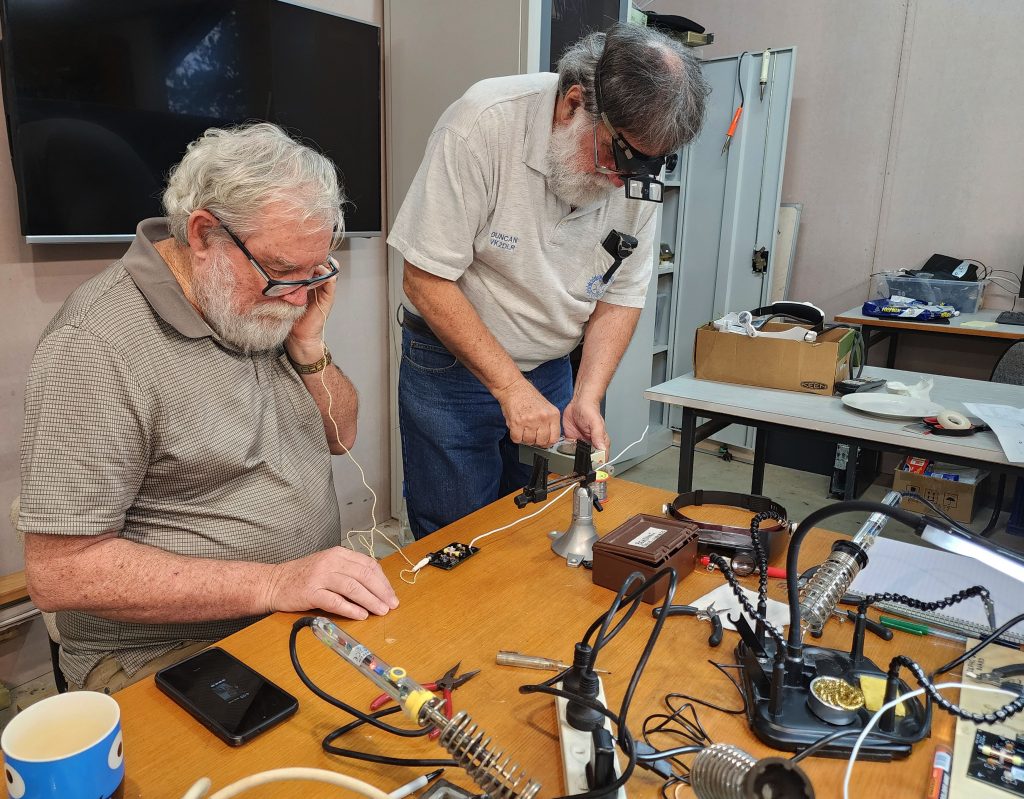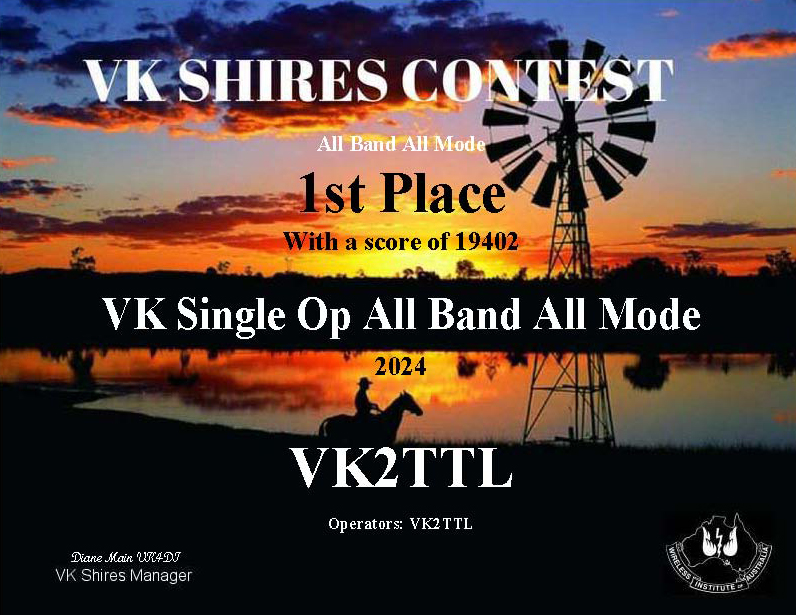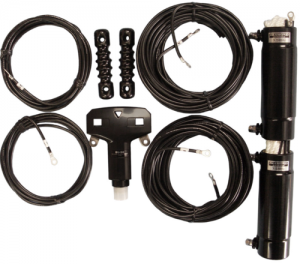WELCOME TO SARC
Serving the Northern Rivers of NSW
Members are advised that membership fees are now due. Please check the Membership Page for payment details.
NET NUMBERS:
Dawn Patrol numbers for the week were 29
MONDAY March 24, 2025 – 2 metres Parrots Nest. There were three operators on Monday night for the 2 metres net, Jonie VK2ZJJ as VK2SRC, Paul VK2AMT and Duncan VK2DLR.
Tuesday March 25, 2025. – The Diginet
This evening, logging in on 2 metres Parrots Nest with Paul VK2AMT as VK2SRC was: Duncan VK2DLR and Jonie VK2ZJJ. It didn’t take Duncan and I long to QSY to “our” frequency of 3.590 USB for another session with Fldigi and Olivia 8-500.
Jeff VK2NU is normally on the net but his computer and radio weren’t communicating, so he bowed out in frustration. Both Duncan and I have felt that frustration too when the system doesn’t work. In the end, it was just the two of us, no-one else dropped in. We had no problem finding topics to discuss. Duncan has found a collection of digital SSTV and digital voice software for us to check out. The band was excellent, low noise and very little static from weather systems. It’s amazing how good our 3.590 MHz frequency has been over the months. Duncan has been making progress with another parrot repeater, a very handy device for checking the quality of voice and also images. The Meshtastic system is also on his list of projects. Another project that will need discussing by the club is a request from VK4 hams to have a 2 metre horizontally polarised CW beacon transmission in our area. The Yaesu FT897 has a unique Beacon feature which allows an operator to record a message for the radio to convert to a 10wpm CW message that can be repeated at a variable interval. TX power and suitable antenna choice need to be considered. It was another excellent net. Duncan and I had no trouble going on past 9.30pm on topics that were all technical in nature. Thanks to Duncan for his wonderful support.
Cheers from Paul VK2AMT
Wednesday March 26, 2025 – Mt Nardi. 3 stations made the net this week. Paul Vk2AMT, David VK2ZDR and myself VK2XI. Topics discussed included Donating Blood, Working splits with DX station pile-ups, the Parrots Nest 70cm repeater and turning up late for the net. Join us next Wednesday at 8PM EDST and tell us what you think.
Cheers
Andrew VK2X
Thursday March 27, 2025. On the Woodburn repeater this week, joining Paul VK2AMT as net control we had Dave VK2ZDR, Jonie VK2ZJJ and Andrew VK2XI drop in. The main topic of conversation, we were all sick of the constant rain. The use of pressure washers also was discussed.
Friday March 28, 2025. The number of operators on the SARC After Dark Net 28-3-2025, were 9. Taking part last week were VK2WSR Jeff, VK4BT Peter Jr, VK4SD Danny, VK4GSI Georgie, VK4GCR Ralf, VK2ZDR Dave, VK2MBJ Brian, VK2ARD Ross and VK2CVD Steven.
Topics mentioned on the net on Friday night were Wheelchair issues and
reliability, Injuries sustained in taking a fall, Amounts of rain, Fire at the abandoned Richmond River High School, lack of Autumn, general signals and propagation conditions.
If you would like to contribute to the conversation, come and join in
next Friday night. The more the merrier.
Cheers Jeff
VK2WSR
The Redfest 25 has a new venue, so a new poster and some prizes also, so another poster, below. Check it out.
(Below): Chris (Foundation candidate) and Duncan preparing for the Practical Foundation test.
The Clubrooms are not just for meetings
On Wednesday 9th October, Sara VK2SUN and Paul VK2AMT met up with Duncan VK2DLR at the clubrooms. The object of the meeting: a day soldering electronic components onto a PCB. Neither Sara or I had any experience in doing this and were dead keen to try. Duncan had procured three crystal radio kits for us to practice on. Yes, the kind that kids the world over had put together years ago. One thing that I had problems with was eyesight. I found that headband type magnifiers are often clumsy and have poor quality magnifiers. I persevered with normal glasses. There was lots of laughter and stuffups requiring desoldering. At the end of the day, three crystal radios were finished. Two worked, mine didn’t. Who knows why, perhaps a faulty component. More important than that was the soldering practice. It’s amazing the difference solder types and thickness plus iron temperatures make. Both Sara and I had basic Duratech 30 watt irons with a temperature control on the handle, Jaycar products. They were excellent and didn’t cost the earth. We found that thin old fashioned lead solder is much easier to work with on small components than lead free or thicker solder types. A great day. Three friends having lots of fun. The clubrooms are ideal for these types of days. Many thanks to Sara and Duncan for a fun and informative day.
de Paul VK2AMT
SARC Goes MAD
Five SARC members went MAD (Microwave Activity Day) today, enjoying activities on the higher bands 23cm & above, during the July 2024 MAD.
Graham VK2BWC & Graeme VK2QJ setup portable at Maclean Lookout (QG60ON) with all five bands 23cm to 3 cm, contacts were made on 23cm, with Trevor VK4AFL Brisbane, Scott VK4CZ Brisbane, Andrew VK2XI and Paul VK2AMT at St Helena, plus Tony VK2VL at Braunstone. The Brisbane 23cm beacon was also heard & decoded. Unfortunately the Wifi & NBN QRM @ 20/9 made 2.4Ghz & 3.4GHz unworkable, there were no contacts made on 5.7GHz or 10GHz, but we did receive the 10GHz beacon briefly, I believe this was due to aircraft enhancement.
Andrew VK2XI & Paul VK2AMT setup at St Helen Lookout (QG61SI) with 23cm, where they made contacts with VK4AFL Brisbane, VK4CZ at Brisbane,& VK2QJ at Maclean Lookout. Tony VK2VL worked from his home QTH (QG60LE).
MAD is not a competition, instead it is a casual get together of operators with the idea of promoting activity on bands 23cm and above, while testing locations & equipment. It does not matter if you are portable or home station, all are welcome.
It is great to see SARC members activating the higher bands, if this is something that interests you, and have equipment for 23cm or above, the next MAD will be held 29th September 2024.
If you would like to join in, but don’t have equipment, team up with someone that is planning to go MAD.
A big thanks to those stations contacted, VK4AFL, VK4CZ, VK2XI, VK2AMT, and VK2VL, also thanks to Col VK4UV for trying from a portable location near Crows Nest.
Cheers Graeme VK2QJ
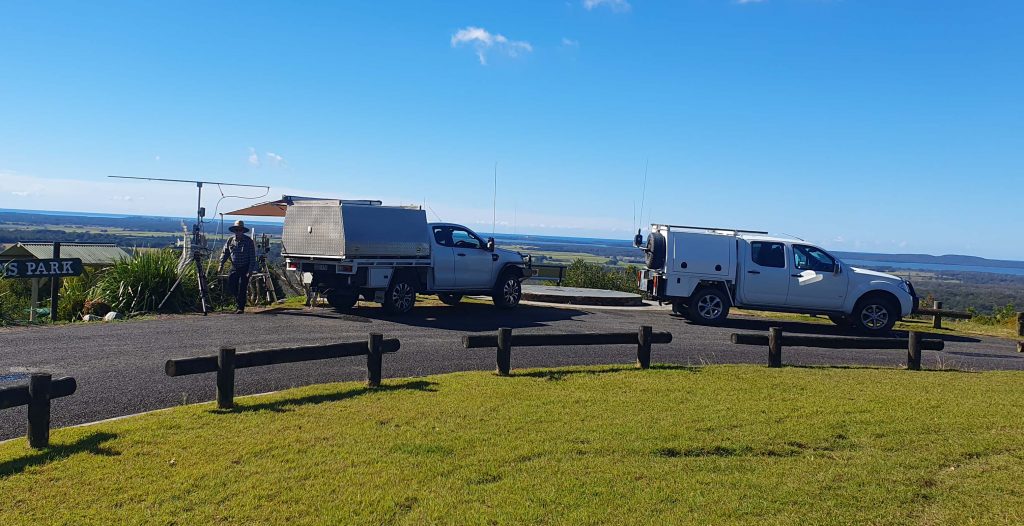

Andrew VK2XI operating from St Helena.
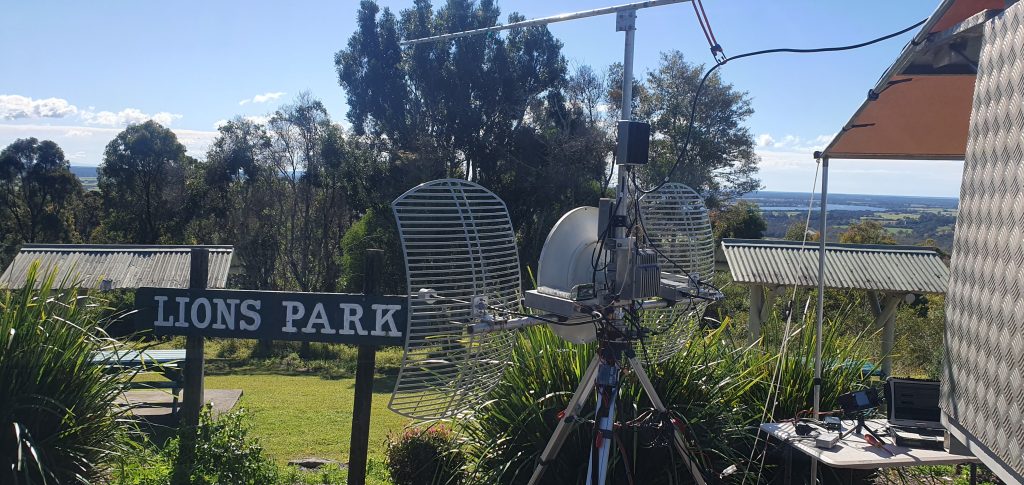
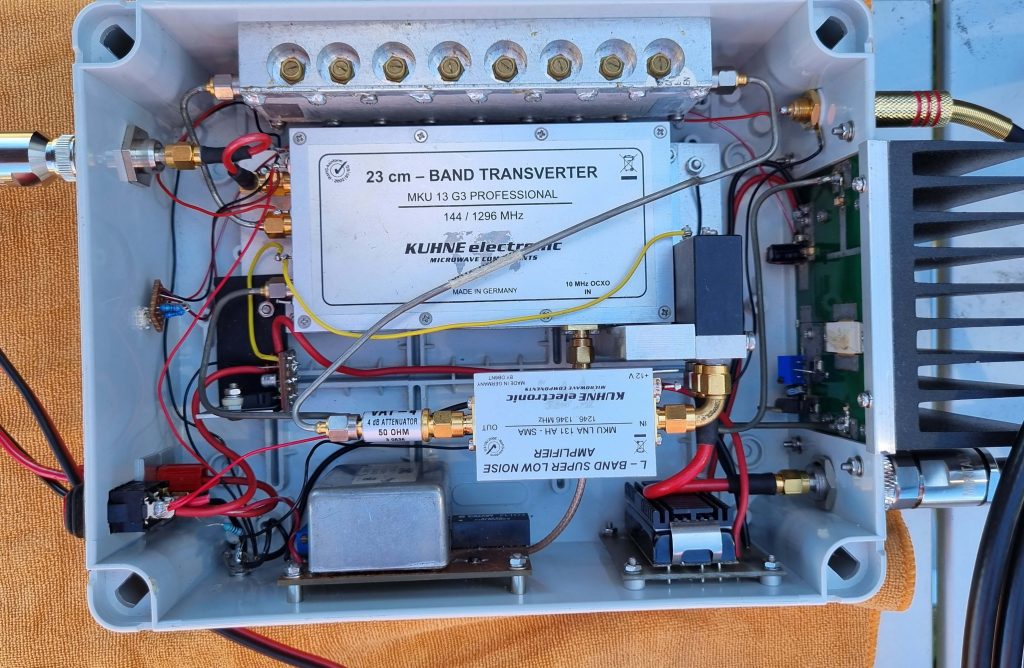
The transverter box with nice Kuhne equipment.
The 2 metre repeater at Parrots Nest is available and the 70cm repeater is available too but the signal is a bit low. The 6 metre repeater is not available at present.
VK SHIRES CONTEST 2024
The results of the VK Shires Contest have been released. These show that the winner of the Single Op All Band All Mode category was club member Rhod Rowe, VK2TTL. Well done Rhod, outstanding effort.
VHF-UHF FIELD DAY 2024 REPORT
SARC members Pat VK2FAAD & Graeme VK2QJ met up at Junction Hill Friday morning, before heading Coutts Crossing to meet up with Graham VK2BWC for a coffee & snack. We then made our way to Vista Point, arriving just in time for lunch, followed by treats supplied by Graham.
The weather threatened but held out all afternoon, allowing all antenna 6m – 3cm bands to be set up by nightfall, Graham assisted Pat to set up his newly completed camper trailer and tower configuration, which proved to be very successful, making setup much easier. Graham headed home late afternoon, after an enjoyable time assisting with setup. Thanks for your help Graham.
Unfortunately due to work commitments, David VK2JUB was again unable to make it for this event, leaving just Pat & myself to cover all eight (8) bands. Tests of the Brisbane beacon (300km) late Friday afternoon was successful on 70cm, 23cm, 13cm, 9cm & 3cm bands, as were a few 23cm & 9cm on-air tests into Brisbane.
After nightfall we kicked back, cooking our evening meal before settling in for a few light refreshments and a chat, while keeping warm out of the wind. It wasn’t long before we cranked up the heater and migrated inside where it was much warmer. The outside temperature dropped quickly Friday night with temperature falling to around -5 Deg C, and heavy frost Saturday morning, the biggest we have both seen up at Vista. Once things warmed up, Pat finished setup of the 2m & 70cm station, before we conducted a few more on-air testing of most bands.
The event started well with various stations worked, including several portable VK4s, things continued well for the first 8Hrs, until most portable stations packed up and headed home, things soon quietened off after that. Late Saturday night we were on track for our highest ever score, with an average of over 9,200 points per hour scored for the first 10hrs. This was not to be, although we still managed our third highest Field Day score. Col VK4UV & Kevin VK4UH made the trip out portable to Mt Mowbullan, were contacts were made on 23cm, 9cm, 6cm & 3cm at a distance of 370km, with the 6cm contact being the first for my IC-905 & SGLabs amplifier, one would have to be very please with this result.
Trevor VK4AFL provided several 305km contacts on 23c & 9cm, Scott VK4I was worked on 6m, 2m, 23cm & 13cm at 314km. Rod VK4VU was worked at almost 300km on 23cm using a single gridpak mounted on a tripod on his back deck, using just 10w. Portable stations VK4B & VK4WIE were also regular contacts, along with several home stations, too many to list. Sunday morning saw Doug VK4OE working portable on 6m & 9cm from Mt Coot-tha (305km). Several VK2 portable & home stations also provided regular contacts, VK2XI portable, VK2ZB portable, VK2AMT, VK2DLR, VK2ELH, VK2TTL, VK2VL, VK2XDS, VK2ZDR, and many others.
We shut down just after midnight Saturday to catch a bit of shut eye, by then the outside temperature was around 2 Deg C. Around 3:30am Sunday morning the rain and wind arrived, making for a damp start to Sunday morning, the rain continued though until around 2pm Sunday afternoon. This rain impacted contacts on 2m, 70cm, 23cm & 13cm, but had little effect on 6m, 9cm & 3cm. VK4 contacts were down Sunday due to rain north of Vista affecting signals. During the event the higher band performed well with contacts of 370km on 23cm and 9cm, 6cm & 3cm, and over 314km on 13cm.
We packed down Sunday after the event completion, & between the rain showers, before heading off the hill just after 15:00pm, stopping at Coutts Crossing for a quick break before I made it home around 18:30, with Pat arriving home around 19:30.
As always, it was a great weekend on a hilltop, flying the flag for SARC, & doing what we enjoy, we are looking forward to the Spring Field Day in late November.
Thanks to all that supported & made contact with us during the event, without you it would be nothing.
Regards Graeme VK2QJ
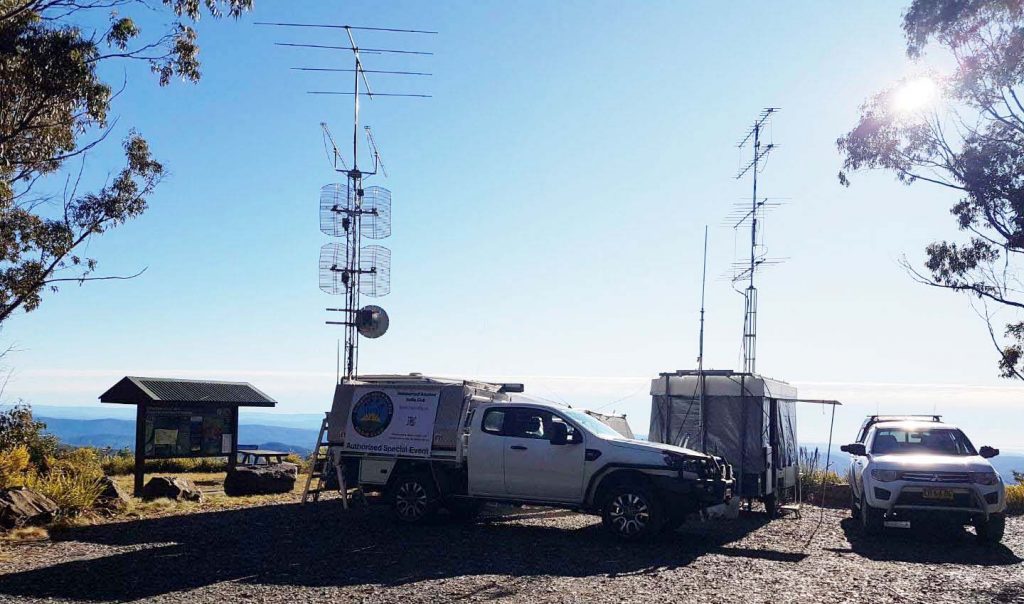
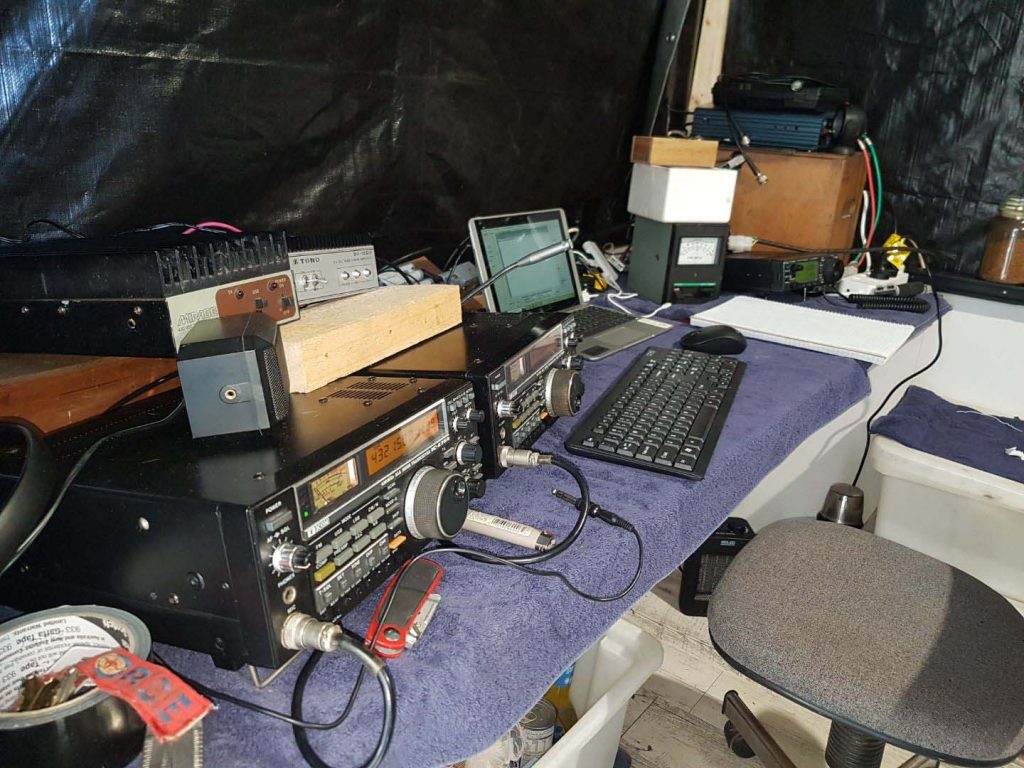
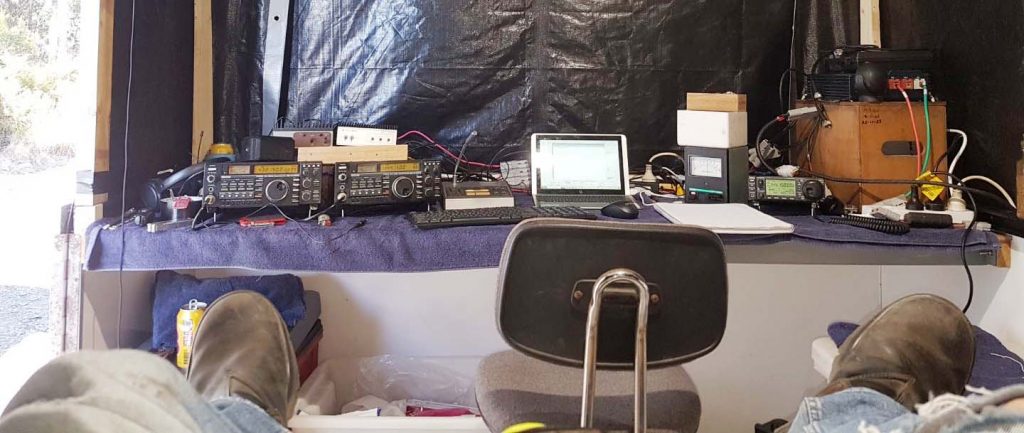
Diamond W-735 40 & 80m Dipole – impressions
The Diamond W-735 is a dual band wire antenna covering 80 and 40 metres. The choke traps act as loading coils on 80 metres, shortening the antenna length on this band, thus making this antenna a good choice where space is limited. An inverted-V installation would make fitting into small yards even easier. Initial tests display a SWR figure that is easily within the 3:1 SWR range of transceiver antenna tuners. Some users have said that the bandwidth is a bit limited but that’s not surprising considering it is a wire antenna with traps or coils. The bandwidth is wide enough that satisfactory SWR can be achieved easily with any tuner. Tuning is performed by folding excess wire rather than cutting it. On 3.604, the SWR is 1.6, on 3.575 it is 1.11, on 7.100 it is 2.2. The quality of the parts is extremely high and the weather sealing of the coils is excellent. It has a 1:1 balun and a SO-239 socket. The power handling is 1.2kW PEP. This antenna has outperformed longer G5RV and OCF dipoles at my location, even at a modest 6m height. It’s an antenna which has me active on 80m in particular, so it’s a keeper. It could also be used as a portable antenna with a single pole, as an inverted-V.
de Paul VK2AMT
AMATEUR RADIO BEACONS
Recently we have heard that operators in VK4 would really appreciate it if there was a beacon on 2 metres somewhere in our area, to aid propagation. This made me think and gather some information about beacons in general. As well as the information below, Amateur Radio NSW offer Morse training: the automated Morse practice transmission operates using the call sign VK2WI in the 80 metre band on 3699kHz. This also serves as a band condition indicator. The well known WWV time clocks have been used for many years to check band conditions. The station transmits on 5 MHz, 10 MHz, and 15 MHz; also on 2.5 MHz and 20 MHz. Propagation testing can also be carried out using WSPR, a part of the WSJT-X Weak Signal suite of programs. WSPR signals can be received and decoded over thousands of kilometres, often only using milliwatts of TX power. There are various websites that offer a “spotting service”. The best known one is PSK Reporter, mainly used to show digital FT8 signals. Another one is the Reverse Beacon Network website. Instead of beacons actively transmitting signals, the Reverse Beacon Network is a network of stations listening to the bands and reporting what stations they hear, when and how well. These are then plotted on a world map.
The WIA’s list of Beacons:
https://www.wia.org.au/members/beacons/data/documents/Aust%20Beacon%20Listing%20101112.pdf
This list is very handy and I recommend printing it out and keeping it close by.
The ACMA’s list of Beacon Licences:
https://web.acma.gov.au/rrl/browse_licences.licence_list?pSV_ID=6&pSS_ID=601
There is a list of HF Beacons under the International Beacon Project:
The International Beacon Project (IBP) is a worldwide network of radio propagation beacons. It consists of 18 continuous wave (CW) beacons operating on five designated frequencies in the high frequency (HF) band.
Beacon Approval Process:
https://www.wia.org.au/members/tac/repeaterlicence
Beacons and repeaters can be licensed through an application process through the ACMA who can supply a callsign. If anyone wants to operate an amateur beacon or repeater station, it must have an apparatus licence and the person operating the station must hold a recognised Standard or Advanced qualification.
An examination of the Band Plan supplied by the WIA:
https://www.wia.org.au/members/bandplans/data/documents/Australian%20Band%20Plans%20200901.pdf
This shows that there are small segments allocated for Beacons in various bands.
A basic beacon can be activated by utilising the Beacon feature in Yaesu’s FT857 and FT897 radios. This allows you to store a message in one of three storage areas. The message can be repeated with an interval that can be varied. The message is transmitted in CW. The speed of the CW transmission can be changed. A number of local SARC operators have tested this successfully on 2 metres, 70 cm and 6 metres. Frequencies used were: 144.230, 144.430, 432.425 and 50.285, CW mode. It is strictly experimental and short term. The transmissions are only likely to be received locally. An interesting experiment if you have one of those Yaesu rigs in the shack. I must admit that Beacons can be regarded as a grey area, licence wise. The frequencies we used were unassigned, which means that they have to be shared. Can a repeated transmission in CW be transmitted on any of our open frequencies? Do we need a Beacon Licence to do this? The feeling is that we can run in automatic mode, including “Repeater like” and “Beacon like” modes, provided that the signal contains station ID information and the transmission process is controlled. It may be possible for a Beacon on 2 metres to be established at one of our repeater sites, should the club approve such a project. Obviously, it would require a good deal of thought and the approval process started. Food for thought.
Cheers, Paul VK2AMT.
Flu precautions : update 1 August
Please stay away if you have a cold or flu-like symptoms.
We are still asking people to sign in as they arrive, using the book on the table at the door. Use of hand sanitiser and social distancing are still sensible things to do.
Get the SARC Newsletter – each Monday by email
To receive the SARC weekly Newsletter you DO NOT have to be a member, it’s available to all.
Simply send your email address to with <please subscribe me> in the subject line.
WHAT’S ON IN 2025
DOWNLOAD CALENDARMembership and Information
For more information about SARC activities and our membership form
Click Here:- SARC Membership & Information Brochure 2024
Or you can download any newsletter from the current and previous year – here:
SEE NEWSLETTERS





